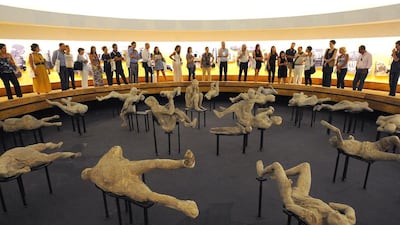POMPEII // Pompeii is rising from the ashes again, despite the worst that Italy’s mafia – and bureaucracy – could throw at it.
The ancient city, buried during a volcanic eruption in the first century, is undergoing a multimillion euro restoration which has seen the preserved bodies of victims go on display at the site for the first time.
But the transformation of one of the world’s most treasured archaeological sites has been a challenge both for archaeologists and for Italy itself.
Archaeologist Massimo Osanna was sent in to turn around the project two years ago amid reports of degradation of the ruins, of theft and even of looting by the Neapolitan mafia, the Camorra.
He now has a 130 million euro (Dh523.6m) budget, most of it from the European Union.
In March, Unesco inspectors – who had threatened to take Pompeii off the list of World Heritage sites – acknowledged that there had been considerable improvements to the site’s conservation.
“This is a really exciting time for Pompeii,” said Mr Osanna. “Thousands of people are working together. We currently have 35 construction areas on the site.”
Pompeii’s transformation includes a new special exhibition of around 20 victims of the eruption, preserved in plaster with their expressions and positions fixed at the very moment they met their fate, carbonised by the intense heat of a 300ºC gas cloud.
The bodies of men, women and children from Pompeii and neighbouring Herculaneum – which was also engulfed by the eruption – are laid out in a wooden pyramid in the middle of an ancient amphitheatre.
A series of night-time visits until September 27 give visitors the chance to explore the site by moonlight, with guided tours, video installations and wine tastings based on an ancient Roman recipe.
“We have followed Unesco’s advice to extend projects beyond the initial deadline of 2015,” said Mr Osanna. “We have the resources and we will carry on working.”
With 2.7 million tourists visiting the ancient city last year, the ruins are the second most visited attraction in Italy after the Colosseum in Rome, and are seen as a symbol of the challenges in preserving Italy’s cultural heritage.
“This is a new era for Pompeii and our efforts are bearing fruit,” said Italy’s minister for culture Dario Franceschini, as he inaugurated the Palestra Grande (Large Gymnasium) on Tuesday, after seven years of restoration work.
The enormous space surrounded by columns is where young Romans played sports until Mount Vesuvius erupted in 79AD.
The region in which Pompeii is located is one of Itay’s poorest, and Mr Osanna said that these economic problems make the site a particularly complex one to work on. He hopes that the bid to improve conservation efforts will be echoed by investment in the surrounding region.
“We want a fast train which goes directly to Pompeii’s archaeological site. We want the area surrounding the site to be just as beautiful as the site itself,” he said.
* Agence France-Presse

